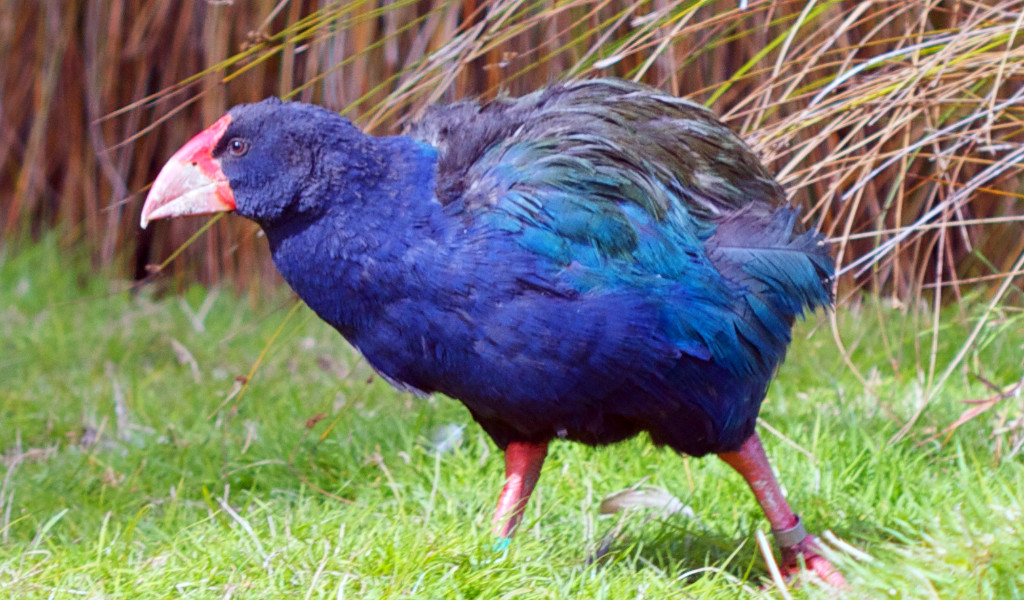
Photo by Harald Selke via commons.wikimedia.org
In the heart of New Zealand’s captivating landscapes resides a remarkable avian wonder, the South Island Takahē (Porphyrio hochstetteri). Native to this enchanting land, this flightless swamphen stands as the largest living member of the rail family.
Referred to colloquially as the Takahē, this splendid bird shares its abbreviated name with the now-extinct North Island Takahē, showcasing a connection to its ancient past. Notornis is another term by which these intriguing creatures are recognized. They are the only flightless bird in New Zealand that is not a member of the Kiwi family.
Exploring the Fascinating Lineage of Takahē
The South Island Takahē’s tale is one of intrigue and gradual revelation. The South Island Takahē is a flightless bird that is native to New Zealand, known for its bright blue plumage, red bill, and white undertail.
Though extensively hunted by the indigenous Māori people, it wasn’t until 1847 that European explorers encountered this bird. The revelation came through fossil bones, shedding light on the existence of this enigmatic creature.
It wasn’t until 1850 that a living specimen was captured, and further expeditions in the 19th century yielded a few more insights into this elusive species. Today, there are about 400+ Takahē in the wild. They are still considered to be a vulnerable species, but they are no longer thought to be extinct.
The intricate lineage of these splendid birds is a journey through time. Anatomist Richard Owen’s classification efforts in the 19th century led to the distinction between the North and South Island Takahē.
Originally categorized as separate species, they were eventually incorporated into the same genus as the closely related Australasian swamphen. Genetic revelations later solidified the distinction, affirming the uniqueness of the two takahē species.
A Remarkable Rediscovery: The South Island Takahē
The annals of conservation history took a remarkable turn in 1948 when the South Island Takahē’s existence was dramatically rediscovered. Venturing into the isolated valleys of the Murchison Mountains, Geoffrey Orbell unearthed a small population of these creatures, captivating the world with their resurgence.
Managed with utmost care by the New Zealand Department of Conservation, the Takahē Recovery Programme has since nurtured Takahē populations on various offshore islands, with the Takahē Valley serving as a stronghold.
This remarkable feat wasn’t confined to the islands alone, as the species was successfully reintroduced to the Kahurangi National Park, marking a significant milestone in their conservation journey.
Takahē: Behavior and Habitat
As inhabitants of alpine grasslands, the South Island Takahē holds a unique position in the ecosystem. Their sedentary lifestyle renders them territorial beings, dwelling amidst the grasslands until snowfall prompts them to descend to the sheltered forests below.
Their diet primarily consists of grass, shoots, insects, and the leaves of alpine grass species. The sight of a Takahē plucking a snow grass stalk, devouring its tender parts, is a testament to the intricate dance between the bird and its environment.
Insights into Breeding and Survival of Takahē
Takahē are monogamous and breed once a year. The Takahē builds a substantial bowl-shaped nest on the ground, sheltered under large tussock grass or tight shrubbery. The nest is usually made of dead grass stems and is lined with soft materials such as feathers or leaves. The female lays 1-2 eggs, which are pale buff or cream in color with variable reddish or purplish splotches. The eggs hatch after about 2 weeks and the chicks are independent at about 1 year old. Takahē reaches sexual maturity at about 2 years old.
Takahē can live 16-18 years in the wild but can live 20-22 years in the conservation program. Human intervention has helped the success rate of the breeding of the bird, and maintaining with the removal of unfertile eggs and captive rearing of chicks contributing to the preservation of this magnificent species.
The journey of the South Island Takahē is one that reflects the resilience of both the bird and those who champion its cause. Island sanctuaries have become havens for these creatures, offering a protected haven where they can thrive without the threat of introduced predators.
The Burwood Takahē Breeding Centre and various translocation efforts have ensured this extraordinary bird has a fighting chance at survival.
The Path Ahead
The dedication of conservationists, researchers, and enthusiasts alike will continue to shape the destiny of these birds. Recently, a pair of Takahe was introduced into the South Island mountains with the aim of boost the existing small population in the wild. The narrative of rediscovery, adaptation, and conservation underscores the vital importance of safeguarding biodiversity.


